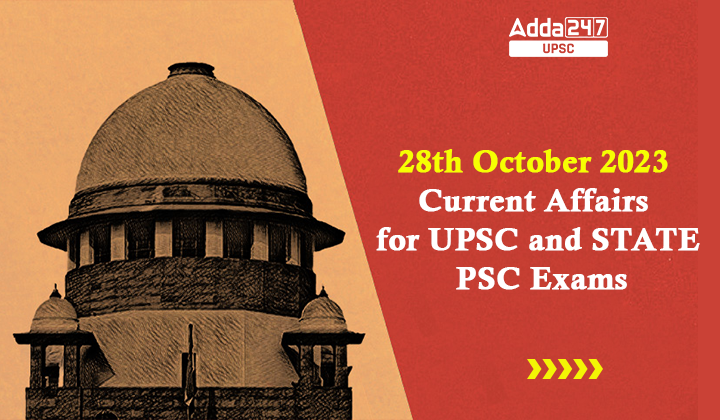Table of Contents
28th October 2023 Current Affair: These current affairs updates for October 28th, 2023, provide valuable information to aid your preparation for UPSC Current Affairs 2023 and State PSC exams. The news headlines covered in the current affairs for October 27th, 2023 include Russia’s Exit from the CTBT: Examining Implications and Historical Context, Reevaluating Dam Safety in India: Confronting Neglect and Challenges, Life on Earth ‘under Stake’ by Unprecedented Climate Change, Shifting Economic Landscape in India: Middle-Class Ascent and Evolving Wealth Distribution.
1) Russia’s Exit from the CTBT: Examining Implications and Historical Context
- Jamrani Dam Multipurpose Project Non-Ratification by Key Countries: The CTBT has not entered into force primarily because key countries, including the United States, China, and others, have not ratified the treaty. Russia’s withdrawal further complicates the ratification process and the treaty’s prospects for becoming legally binding.
- Impact on Nuclear Disarmament Goals: The CTBT is an essential component of global efforts toward nuclear disarmament. Russia’s withdrawal can hinder progress in this area, potentially leading to increased nuclear tensions and arms races.
- Verification and Monitoring: The CTBT includes a comprehensive verification and monitoring system, which helps ensure compliance. Russia’s withdrawal may lead to concerns about transparency and verification, making it harder to assess compliance with the treaty.
- International Criticism: Russia’s decision to leave the CTBT has garnered international criticism and calls for diplomatic solutions. The international community, including non-proliferation advocates, has expressed concerns about the potential ramifications of this move.
2) Reevaluating Dam Safety in India: Confronting Neglect and Challenges
- Ageing Infrastructure: Many of India’s large dams are over 25 years old, which emphasizes the importance of regular inspection and maintenance to ensure their structural integrity and safety.
- Risk Mitigation: The DSA aims to promote risk assessment and mitigation measures, which are essential for reducing the potential impact of dam failures on communities, the environment, and infrastructure.
- Public Safety: Ensuring the safety of dams is not just a technical matter; it’s also a matter of public safety. Dam failures can lead to loss of life, displacement, and economic disruption, highlighting the need for effective regulation and oversight.
- Capacity Building: The DSA recognizes the need for capacity building and training in dam safety, as it mandates the establishment of State Dam Safety Organizations (SDSOs) to facilitate knowledge transfer and skill development in this critical area.
3) Life on Earth ‘Under Stake’ by Unprecedented Climate Change
- Record-Breaking Vital Signs: The report underlines that 20 out of the 35 vital signs used to monitor climate change have reached record extremes. These vital signs include temperature, sea ice levels, and extreme weather events, all indicating the severity of the climate crisis.
- Escalating Consequences: The report makes it clear that Earth is entering uncharted territory in terms of climate change, and its consequences are accelerating at an alarming pace. This emphasizes the urgency of taking action to mitigate and adapt to the impacts of global warming.
- Decades of Warnings: Scientists have issued warnings about the consequences of human-induced global warming for decades. The report underscores that these warnings have not been heeded adequately, and there is a pressing need to address the crisis urgently.
- The “Time is Up”: The report’s stark declaration that “time is up” serves as a powerful call to action, highlighting that immediate and sustained efforts are essential to mitigate the devastating effects of climate change and protect the planet for future generations.
4) Shifting Economic Landscape in India: Middle-Class Ascent and Evolving Wealth Distribution
- Inclusion of Informal Sector: The increase in tax filings suggests a gradual inclusion of individuals from the informal sector into the formal tax system, potentially reducing the size of the informal economy.
- Compliance and Revenue Growth: A wider tax base has the potential to boost government revenue, which can be channeled into public infrastructure, services, and welfare programs, contributing to overall socio-economic development.
- Enhanced Tax Education: The rise in tax filings may also indicate improved tax education and awareness among the general population, leading to more informed financial decisions and responsible tax practices.
- Implications for Economic Planning: A larger tax base provides policymakers with a more robust financial foundation for economic planning, potentially enabling the government to invest in critical sectors and support long-term economic development.



 TSPSC Group 1 Question Paper 2024, Downl...
TSPSC Group 1 Question Paper 2024, Downl...
 TSPSC Group 1 Answer key 2024 Out, Downl...
TSPSC Group 1 Answer key 2024 Out, Downl...
 UPSC Prelims 2024 Question Paper, Downlo...
UPSC Prelims 2024 Question Paper, Downlo...





